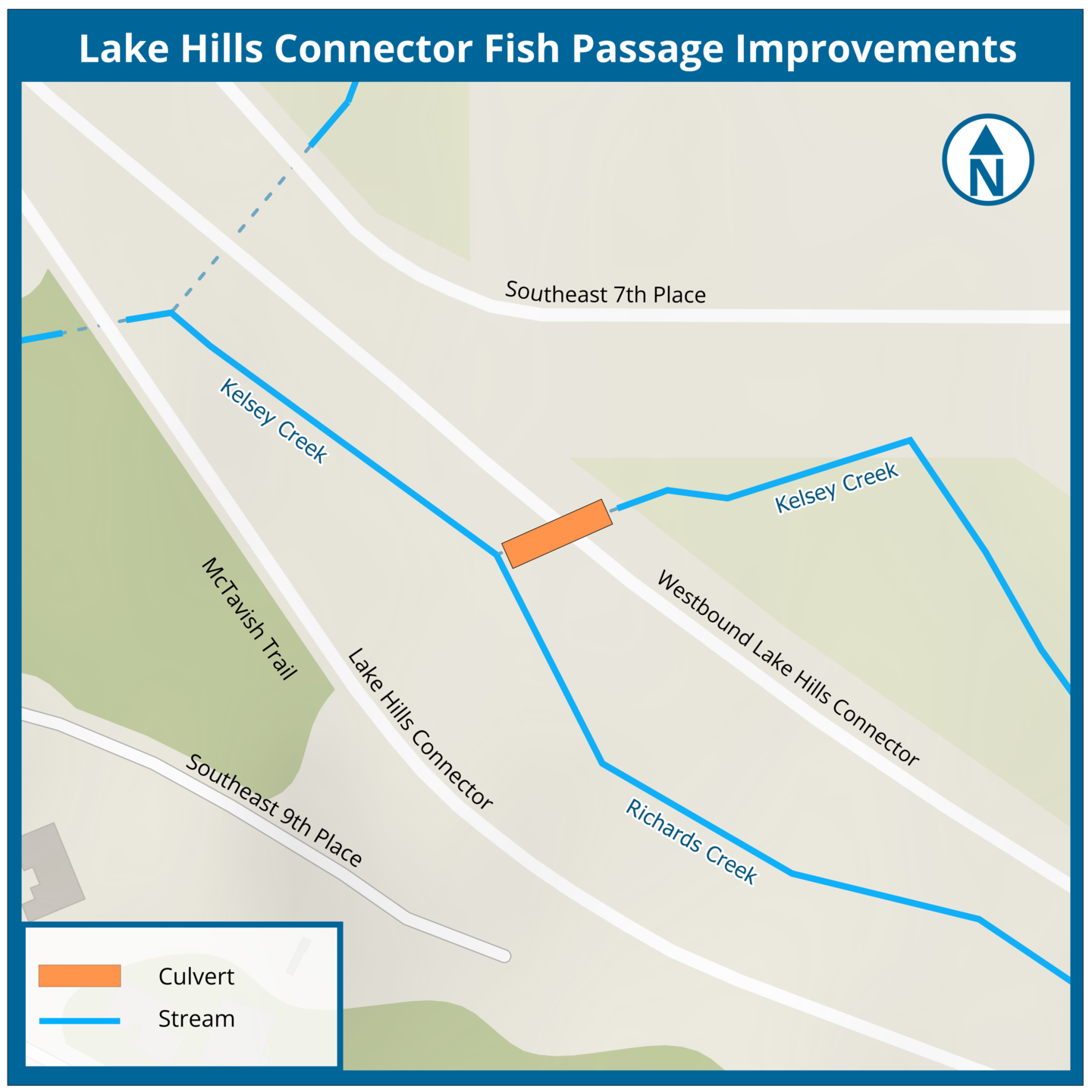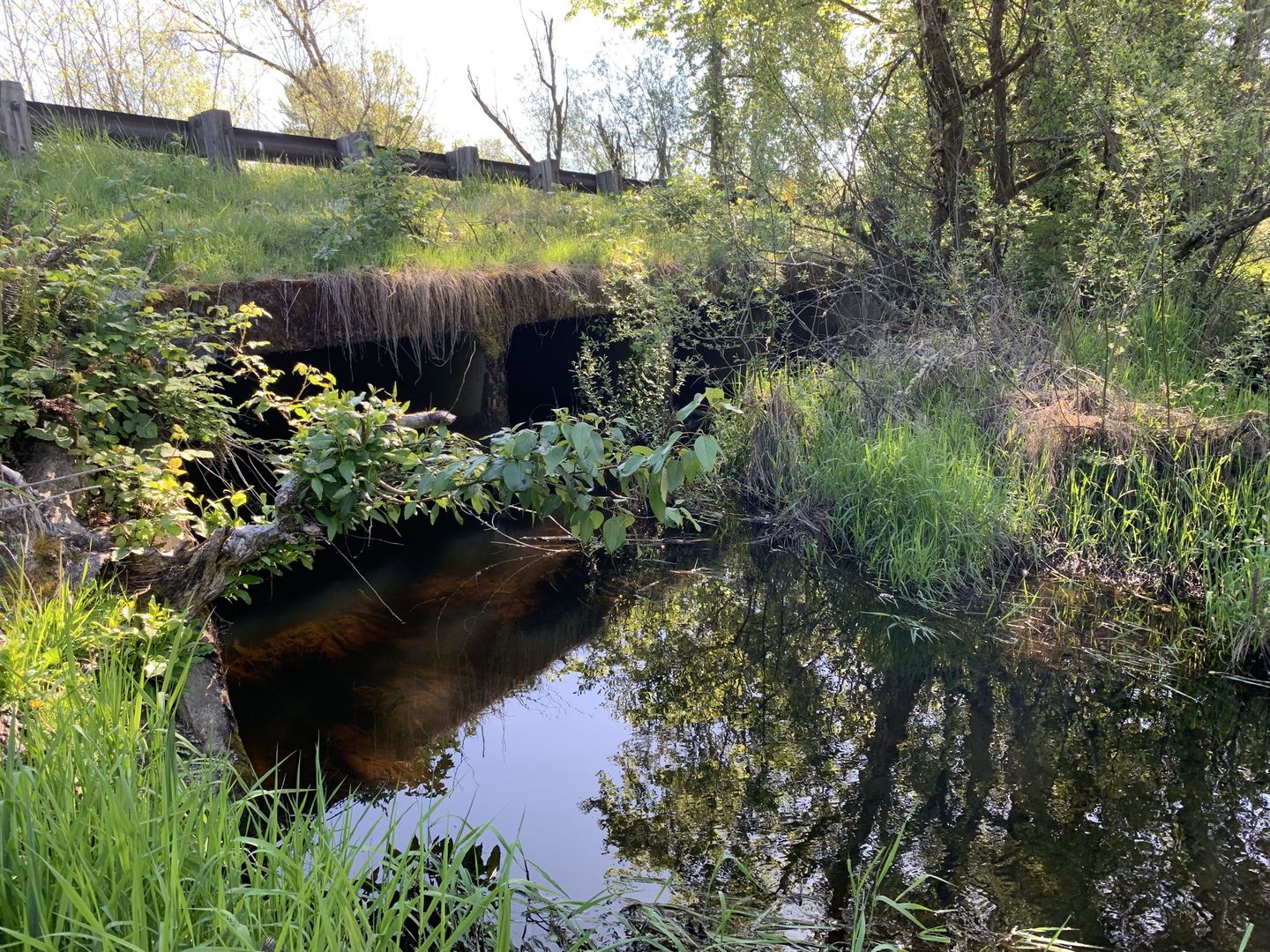The Kelsey Creek Lake Hills Connector Barrier Correction Project is an important restoration effort by the City of Bellevue to improve fish passage to the Greater Kelsey Creek Watershed. The current culvert structure, located under the westbound Lake Hills Connector Blvd, blocks fish from reaching upstream habitats critical for spawning and rearing. This project is part of Bellevue’s Fish Passage Improvement Program which targets protecting and restoring local ecosystems and supporting the health of native fish populations.
Why This Project is Needed
Fish passage barriers, like the existing culvert at Lake Hills Connector, prevent salmon and other fish from accessing miles of upstream habitat, which they need to reproduce and thrive. The current culvert collects sediment and debris, making it difficult for fish to pass, especially during periods of low water. The Washington Department of Fish and Wildlife (WDFW) has classified this structure as a full barrier to fish passage. Removing this obstruction will not only enhance fish habitat but also contribute to the overall health of Kelsey Creek and the surrounding ecosystem.
This project supports regional salmon recovery goals found in the Lake Washington/Cedar/Sammamish Chinook Salmon Recovery Plan (WRIA 8), and process-based stream restoration for the endangered Chinook Salmon and aquatic species that call Kelsey Creek home. and restoring natural stream habitats
Project Location
The project is situated in the Wilburton neighborhood, under the westbound lanes of Lake Hills Connector Blvd, near SE 8th St. The existing culvert is located at the confluence of Kelsey Creek and Richards Creek (see figure below), which are important waterways for local fish and wildlife.
Project Funding
The project is funded through a combination of city resources and external grants. WRIA 8’s Cooperative Watershed Management (CWM) program has provided funding to support the Alternative Analysis phase. Additionally, the City is seeking federal funding from the Federal Highway Administration (FHWA) Culvert Aquatic Organism Passage (AOP) program to help cover the subsequent phases of the project. This funding will significantly reduce the financial burden on local taxpayers while ensuring the project moves forward efficiently.
Project Approach
The project will be completed in three phases:
- Phase 1: Alternative Analysis phase – This phase is currently underway. It includes studying the problem and exploring possible solutions. Consultants will evaluate the condition of the creek and culvert, conduct surveys, and model the stream’s flow to identify the best way to improve fish passage.
- Phase 2: Design – Once a solution is selected, the next step is to design how the solution will be implemented, making sure to address traffic, environmental and regulatory concerns, and public safety.
- Phase 3: Construction – The final phase will involve replacing the culvert based on the selected alternative. The City will ensure that the work is completed with minimal disruption to the surrounding area.
Project Solutions (Alternatives)
The following potential solutions are being considered to improve fish passage at the culvert:
- Perpendicular Precast Structure
- Skewed Precast Structure
- Bridge Structure
Project Benefits
The project will benefit both the environment and the community:
- Improved fish passage: Restoring over five miles of upstream habitat will help resident fish and salmon access critical spawning and rearing habitat.
- Flood prevention: By improving the flow of water through the culvert, the project will help reduce the risk of flooding during heavy rain, protecting nearby homes and streets.
- Improved Natural Stream Process and Habitat: Improving natural stream processes (i.e., sediment transport), enhancing riparian and floodplain habitats.
- Supporting regional goals: The project aligns with broader environmental efforts to restore salmon populations and improve the health of local waterways.
Project Timeline
- Alternative Analysis Phase: Ongoing through Q1 2025
- Design Phase: Expected to begin in Q3 2025 and finalize by Q4 2026
- Construction Phase: Estimated to start in Q2 2027 and complete by Q1 2028
Opportunities for Public Input
The City of Bellevue values the community's input on this project. There will be several opportunities to provide feedback in the next phase of the project. During the construction phase, Residents will be notified in advance of any road closures or construction impacts, and the City will work to minimize disruptions. Your input is essential in helping the City balance the needs of the environment with the daily lives of residents.


